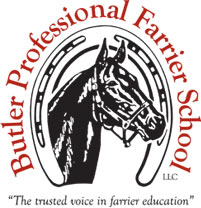As an American farrier that has shod horses from coast to coast and border to border for over five decades, I am amazed at the many different ways people care for their horses. What is considered neglect in some areas, in another is considered responsible care. There is variance in area and in breeds, […]
Often farriers are asked about the rings on the horse’s foot. They have the potential of giving us twelve months of information about a horse’s health. Visible rings indicate there has been some disturbance in the metabolism of the horse affecting the keratinization of the hoof. The indentation or ring is formed sometime before it […]
In the fall, as the temperatures drop, horses will get some relief as external parasites like flies, mosquitoes and ticks begin to die off. We tend to think of parasite control as something we do in the spring because as the temperature rises, we see and hear the flies and mosquitoes. But fall is also […]
Farriers are presented with different horse feet scenarios. Often these come as a last resort from horse owners. This was a horse that was injured 4 months ago. The owner was not sure how the horse injured himself. There is a bulge at the coronary band and the right front foot is beginning to […]
There have been many changes in the farrier industry in the past 60 years since I shod my first horse. Some are more important than others. All have increased the income and prestige of the farrier as a professional craftsman and tradesman. Horse population increase. Horse population and popularity as a recreational outlet has increased. […]
Horses have a thick skin insulated by fat and thick winter hair. The horse’s integument (its hooves and skin) has an underlying dermis that contains AVAs (arterio-venous anastomoses). These vascular systems allow the body to shunt or divert blood away from its surface area periodically to keep the animal’s central core warm
The average life expectancy of a horse is around twenty-five or thirty years of age. One year of horse age is comparable to 3 years of human age. In other words a 25 year old horse would be comparable to a 75 year old human and a 30 year old horse would be comparable to a 90 year old human.
In the mid 70s, Dr. Doug Butler went to Cornell University to get an advanced degree because he wanted to further his understanding of the horse.
Happy New Year! The New Year brings with it a determination to better ourselves through goals and resolutions. Sometimes it is easy to get into a rut or do “just enough to get by.”One of the wonderful aspects of this craft is that there is always an opportunity to improve.
Reviewed by Jacob Butler CJF, AWCF of Butler Professional Farrier School LLC, January 22, 2014 I enjoyed reading Horse Vet, Chronicles of a Mobile Veterinarian by Dr. Courtney Diehl. It is an easy read with real life stories of what to expect as a horse vet. I think anyone considering the idea of becoming a veterinarian should read this book.
Butler Professional Horseshoeing School
495 Table Road
Crawford, NE 69339
(800) 728-3826
jacob@dougbutler.com
If you think you want to become a farrier (or know someone who does), this book can help you make that decision. Horse owners will learn the importance of choosing a qualified farrier and how to select the “right” one.
[ Get the e-Book Now! ]
